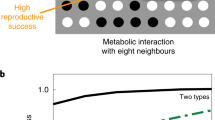Abstract
A “cascade” model depicts microbial degradation of a complex nutrient/substrate through a succession of intermediate compounds. Each stage is characterized by a particular species producing a typical degradation enzyme induced by its own degradation product. The final compound of the cascade consists of a single assimilable substrate used by all species. This results in a competition situation, whereas the contribution of all strains to the production of a complete set of efficient enzymes generates a mutualistic relationship. The model was shown to be appropriate to describe degradation of cellulose by a consortium of Streptomyces sp. strains. The simplicity and the model capacity for generalization are promising and could be used for various degradation processes both at laboratory and environmental scales.


Similar content being viewed by others
References
Atlas RM, Bartha R (1999) Microbial ecology. Fundamentals and applications. Addison Wesley Longman, Reading, MA
Alexander M (1999) Biodegradation and bioremediation, 2nd ed. Academic Press, San Diego
Dehority B (2003) Rumen microbiology. Blackwell Nottingham University Press, London
Williams ST, Lanning S, Wellington EMH (1983) Ecology of actinomycetes. In: Goodfellow M, Mordarski M Williams ST (Eds) The biology of actinomycetes. Academic Press, London, pp 481–528
Schwarz WH (2001) A list of cellulolytic bacteria. Available from http://www.wzw.tum.de/mbiotec/cellmo.htm
Tomme P, Warren RAJ, Gilkes NR (1995). Cellulose hydrolysis by bacteria and fungi. Adv Microb Physiol 37:1–81
Godden B, Legon T, Helvenstein P, Penninckx MJ (1989) Regulation of the production of hemicellulolytic and cellulolytic enzymes by a Streptomyces sp. growing on lignocellulose. J Gen Microbiol 135:285–292
Updegraaf DM (1969) Semi-micro determination of cellulose in biological materials. Anal Chem 32:420–424
Schlochtermeier A, Niemeyer F, Schrempf H (1992) Biochemical and electron microscopic studies of the Streptomyces reticuli cellulase (avicelase) in its mycelium-associated and extracellular forms. Appl Environ Microbiol 58:3240–3248
Roques H, Yue S, Saipanich S, Capdeville B (1982) Faut il abandonner le modèle de Monod pour la modélisation de processus de dépollution biologique? Water Res 16:839–847
Abbot AJ, Nelsestuen GL (1988) The collisional limit: an important consideration for membrane-associated enzymes and receptors. FASEB J 2:2858–2866
Thierie J (2004) Modeling threshold phenomena, metabolic pathways switches and signals in chemostat cultivated cells: the Crabtree effect in Saccharomyces cerevisiae. J Theoret Biol 226:483–501
Eriksson K-EL, Blanchette RA, Ander P (1990) Microbial and enzymatic degradation of wood and wood components. Springer-Verlag, New York
Author information
Authors and Affiliations
Corresponding author
Rights and permissions
About this article
Cite this article
Thierie, J., Penninckx, M.J. Modeling of Competitive Mutualistic Relationships. Application to Cellulose Degradation by Streptomyces sp. Strains. Curr Microbiol 55, 507–511 (2007). https://doi.org/10.1007/s00284-007-9022-7
Received:
Accepted:
Published:
Issue Date:
DOI: https://doi.org/10.1007/s00284-007-9022-7




